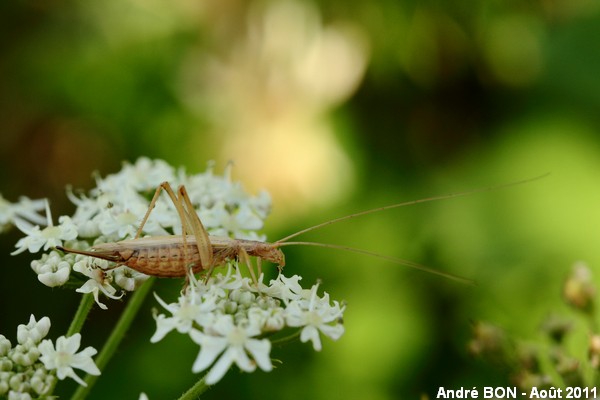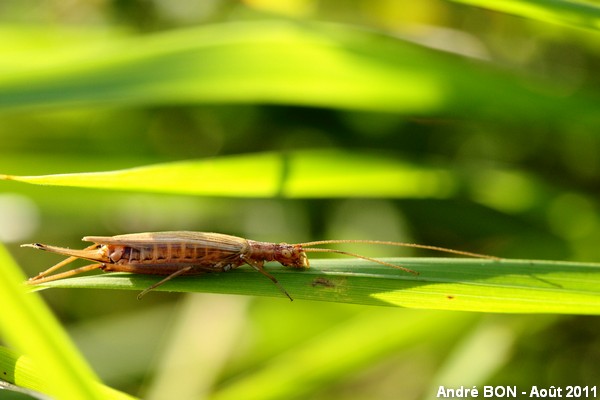


| Italian Tree Cricket (Oecanthus pellucens (Scopoli, 1763)) |



|
|
Scientific name: Oecanthus pellucens (Scopoli, 1763) Common name: Italian Tree Cricket French name: Grillon d'Italie, Oecanthe transparent, Grillon transparent. Order: Orthoptera Family: Gryllidae Wingspan : 10-13 mm for males; 11-14 mm for females. The antennae are longer than the body. Biotope: Dry and sunny places: Dry meadows with shrubs and bushes, fallow lands, vineyards. The Italian Tree Cricket is generally observed at about 1 metre high, perched on vegetation. It only very occasionally goes down to the ground very occasionally. Geographic area: Southern part of the Palaearctic region with a northern limit in Belgium, in southern Germany, in the Czech Republic and in southern Poland. North Africa, Near-East. Observation period : July to October. |
The Italian Tree Cricket is a small size cricket with a slender and elongated body. It is greenish white to pale brown or beige. The head is held almost aligned with the body unlike most of other orthoptera which hold it perpendicularly. The tegmina a rather long, a little longer than the body, and almost translucent. They are stuck on the females' body and larger on males. The abdomens of females end with a long and straight ovipositor. The Italian Tree Cricket feeds on plants, on flowers and on small insects. Females lay their eggs in plant stems. The yearly development cycle includes 5 stages. A few days after the last moult, males begin to emit their song from about 5 PM to 3 AM in the morning. Their song is very soft and pleasant to hear. There is one similar but rarer species, Oecanthus dulcisonans, in the extreme southern European regions. It is very difficult to distinguish one species from the other and the males' song is the most reliable criteria. Oecanthus dulcisonans is slightly larger, with longer hind wings protruding from the tip of the tegmina. The sternum is more slender (under side view needed). |
| [To know more about the Italian Tree Cricket] [Next picture] [Top] |

|
Were are here not very far from the northern limit of the Italian Tree Cricket's range. That's why this is a protected species in Ile de France (region of Paris). This is the third protected species I have observed on this small calcareous meadow. The other ones are the European Mantis (Mantis religiosa) and the Weaver's Fritillary (Boloria dia). The ovipositor at the abdomen tip and the tegmina stuck on the body indicate one female. |
| [To know more about the Italian Tree Cricket] [Next picture] [Previous picture] [Top] |

|
I have only shot pictures of females until today. |
| [To know more about the Italian Tree Cricket] [Previous picture] [Top] |

|
This Italian Tree Cricket is lying on the support to hide. With its brown colour, the camouflage would have been more efficient among dry vegetation. |